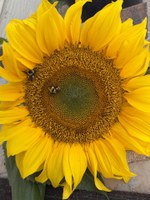Dakota Gardener: Growing giants
(Click an image below to view a high-resolution image that can be downloaded)
By Emily How, Horticulture agent
NDSU Extension – Ward County
“This is huge, it’s taller than the garage!”
The plant in question was a sunflower. And it was, in fact, taller than the garage. What started as a pack of seeds I had gotten for 50% off at a local garden store and just tossed into a bare spot of my garden was now the first thing people noticed.
The sunflower variety was not an ornamental variety, like the ones I had growing in my other flower beds. This one is called Mammoth Grey Striped sunflower and from the name I should have guessed that it would be huge! But it’s hard to imagine what an eight- to ten-foot-tall plant looks like from one tiny seed. The Mammoth Grey Striped sunflower is an heirloom variety that produces a single flower on one stalk. Mind you, it is a single flower that can be up to 14 inches!
As the sunflower grew, I watched as it tracked the sun. This process is called heliotropism. Young sunflowers will track the sun turning from east to west before reorientating themselves back to the east during the evening, waiting again for the morning sun to rise. Once the flower becomes more mature, the flower will stay facing the east. This allows the sun to warm the flower quickly making it a popular spot for male bumblebees to use it as a resting spot to sleep throughout the late summer and early fall.
In the late summer, my Mammoth Grey Striped sunflowers and my prettier, ornamental sunflowers provided a reliable source of food for pollinators. Bees of all varieties swarmed to them for food. These plants also provide habitat for many beneficial insects, such as lady beetles and soldier beetles which prey on pests in the garden.
Sunflowers offer more than just food and habitat for pollinators; after the growing season is over, the sunflowers can be harvested for seeds. Sunflower seeds are high in oil and are great for roasting. In the winter, the seeds also serve as a valuable food source for native birds when protein sources are scarce.
Sunflowers have their benefit in the garden as well. They belong to the Helianthus family, making them a great plant for crop rotation. Because sunflowers have taproots, they make for a great cover crop in areas with compacted soil.
While the flower is the most noticeable part of the mammoth sunflower, the second most noticeable part is the flower stalk. The stalks are not only tall, but thick to support the weight of the flower. These sturdy stalks are useful beyond supporting the sunflower. If you let them dry over the winter, they can be used as a trellis support for vining produce such as tomatoes, peas and cucumbers. The stalk can also be added to your compost pile.
Not only are sunflowers versatile in use, they are native to the North Dakota and the rest of the continental U.S. Next year plant a sunflower, you never know what beauty they may add to your garden.
NDSU Agriculture Communication – Oct. 30, 2025
Source: Emily How, 701-857-6444, emily.how@ndsu.edu
Editor: Kelli Anderson, 701-231-6136, kelli.c.anderson@ndsu.edu




